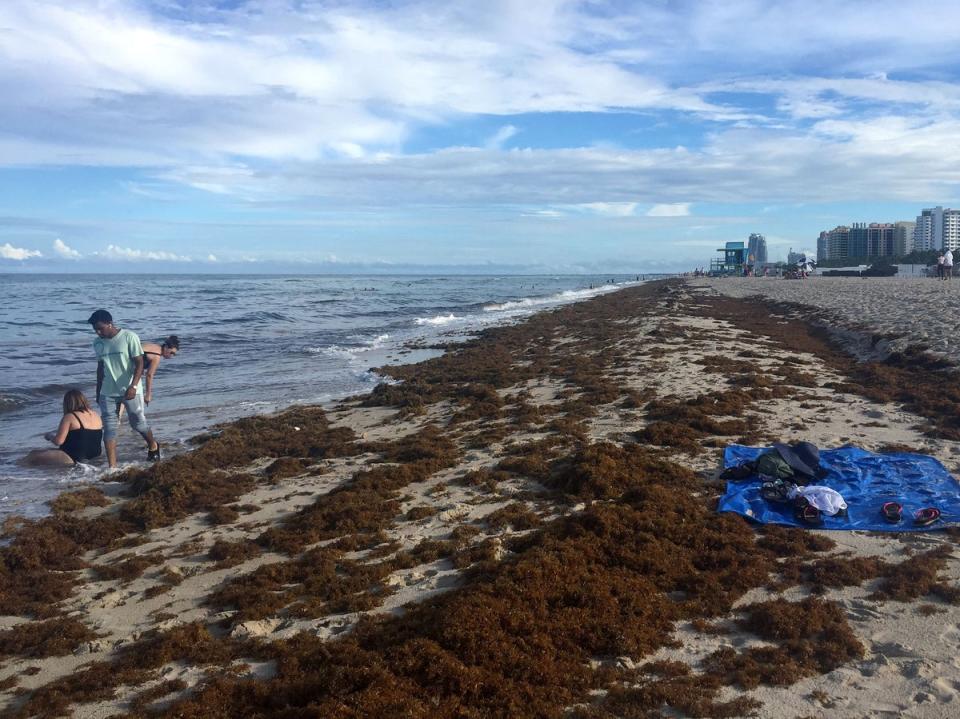Massive blob of seaweed heading towards Florida beaches threatens putrid consequences
A mass of seaweed stretching across 5,000 miles is threatening to cover beaches in Florida and the Caribbean with a putrid slimy substance.
The scientific name for the brown seaweed is Sargassum and the blob heading to Florida weighs in at about 6.1 million tonnes. It could start hitting the Florida Keys in the coming days, according to the Miami Herald.
The season for the seaweed extends from March until October and experts say Miami Beach is set to be a hotspot, with this year’s bloom expected to be one of the largest since records began.
The climate crisis and other human activities have led to a number of large seaweed blobs since 2011.
A new record has been set every year for the last half-decade.
An Optical Oceanography professor at the University of South Florida, Dr Chuanmin Hu, told The Herald that “we cannot predict whether this year will set a new record”.
“All we can say is this year will be another major sargassum year on the level of the average for the past five years,” he said.

While the seaweed itself isn’t dangerous, it does carry jellyfish, sea lice, and other creatures which may bite or sting.
The seaweed “rots under the Florida sunshine quickly. It smells very bad and chases away tourists,” Dr Hu noted.
The smell is caused by the release of hydrogen sulfide and may lead to health problems for those with respiratory issues. The seaweed can also smother young turtles usually hatching on the beaches from August to October.
In Miami-Dade County, the local authorities spend millions each year getting rid of piles of seaweed.
Dr Hu said the seaweed won’t be spread out evenly across Florida beaches – the eastern coast facing the Atlantic Ocean will be hit the hardest as it’s dragged along the coast by the Gulf Stream.
Miami Beach and West Palm Beach usually get struck harder because they are barrier islands.
States with Atlantic coastlines to the north of Florida may also be hit.
“Most beaches may be spared,” Dr Hu said. In areas such as Miami Beach, the seaweed will strike at high tide as the wind is blowing west.
Sargassum needs nitrogen and phosphorus to flourish – the levels of nitrogen have increased following the release of sewage and fertilizer runoff into the ocean.
Dust from the Sahara Desert drops phosphorus over the water and storms may stir up the slime feeding the seaweed from the bottom of the ocean.
“Taken together, they’ve fueled the major sargassum blooms in recent years,” Dr Hu told The Herald. “It’s really difficult to pinpoint which is the dominant factor.”
He added that scientists believe the climate crisis is making the problem worse as more rainfall than normal leads to more runoff from farms and urban areas entering the sea and also pulls the dust from the Sahara from the atmosphere down to the sea. Stronger storms also dig up more muck from the seafloor.
“It will become a new normal,” Dr Hu said of the seaweed’s presence. “Actually, it has already become a new normal compared to 10 years ago.”
Before 2011, there hadn’t been enough Sargassum in the sea to use satellite images to study its development, but the technology can be used now that 5,000-mile stretches of the seaweed are common.
The researchers said in their report that there’s “a glimmer of hope that the overall 2023 bloom may not be as large as previously feared”.
“The Miami-Dade parks department has been well aware of this situation not just from this year but from past years, so they are well prepared to deal with it,” Dr Hu noted.


